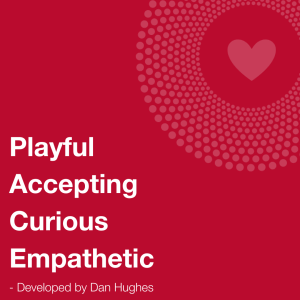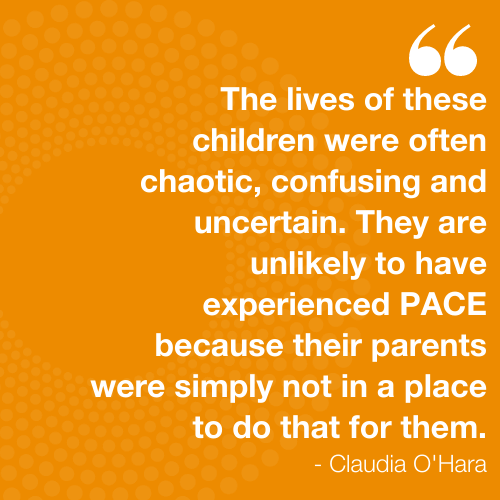
Relationships matter
Therapeutic Specialist Claudia O'Hara shares her reflections on the principles of therapeutic parenting and why parenting this way will benefit all children.
This article was written by Claudia O’Hara, a Therapeutic Specialist at the Australian Childhood Foundation, working in the ACT Together consortium.
It is with a full and joyous heart that I read my daughter’s end of year school report. Not because she had aced maths and English… she hadn’t! Or because she had excelled in the debate team or won a sporting accolade… she hadn’t! My heart swelled with joy because her report reflected the incredible human being I know my daughter to be. It describes her as having ‘a positive attitude to life. She consistently treats everybody around her with a kind, sensitive and generous attitude.’
To see this reflected in my daughter’s approach to the world brings hope and validation to the values we uphold within our family and our approach to parenting. I practice as a parent what I “preach” as a therapist – my children are valued members of our household where their emotions, experiences and perceptions are respected; PACE is a part of our daily interactions and I model (mostly) appropriate coping skills; we experience rupture and repair, I offer co-regulation when they are overwhelmed and advocate for them 100% of the time. It seems that this therapeutic stuff REALLY works!
As a Therapeutic Specialist, I have the privilege to work with many incredible children who have adapted to and survived extraordinarily challenging circumstances. I also have the privilege to work with their carers and wider care team who diligently focus their efforts toward supporting the child to recover from their early life adversity and re-adapt to a less dangerous world. This work can be tiring and, at times, seems thankless, but is always worthwhile.
So, what helps? What tips and advice can I give from my knowledge and experience that can guide those looking after such a child? From my perspective, the relationship is the conduit through which the best work can occur. There isn’t a 10-step program that makes the magic happen.
The magic is in the relationship, and it is something that everyone can do – no university degree required!
Think about the ways in which relationships impact positively on you. What are the key attributes a positive relationship has? From my personal and professional perspective, this is…
- Feeling seen and heard
- Feeling validated and contained
- Receiving empathy
- Knowing that you are not alone
- Knowing that a repair is possible and not all ruptures lead to loss
These elements provide a solid ground upon which to stand and face the world – interdependently, with the network around you.
But what do you need to make this happen? In essence, you need a PACEful attitude (more about that below!), some capacity for self-reflection, an awareness of the evidence for therapeutic parenting, and people around you who ‘get it’ and support your approach. I will very briefly describe each element and encourage you to follow up with your own research to develop your skills.
PACE
 What is a PACEful attitude? It is P = playful, A = accepting, C = curious and E = empathic
What is a PACEful attitude? It is P = playful, A = accepting, C = curious and E = empathic
This is an approach developed by psychologist Dan Hughes and is highly effective in supporting open, attuned communication. In approaching a situation with an open and accepting attitude, we are encouraged to leave our own assumptions at the door, along with the desire to ‘jump in’ and ‘fix things’. We are holding our understanding in the background and opening up space to really hear the experience and perception of the other person. We don’t have to agree with it – but we do have to accept that this is their lived experience at that moment. Through this interpersonal, relational connection we can support the other person in co-regulation and keeping their ‘lid on’ (Dan Siegel). This calmer space allows us to use curiosity about what is going on for the person – and helps us understand the behaviour that we observed. For example, think of two siblings having yet another argument – perhaps one child looked at the other in the wrong way, or touched one of their things… and here comes the apocalypse! It would be easy for us as a parent to minimise the experience – in truth, this is not the worst thing in the world to happen and maybe you feel the child’s response far exceeds the situation. We could tell the children to apologise, get over it, move apart from each other – but this may not resolve the situation. Indeed, it may make things worse. The children may not feel seen or understood.
I know myself that when someone ‘doesn’t get’ my frustration, and tells me to ‘let it go’, I feel angrier and more upset – not only am I dealing with the thing that caused me frustration, but others don’t understand what I am feeling or why…the same is true for children. PACE offers a way to connect with the feeling, in the moment, and can help the child move into a more regulated emotional space. The playfulness allows some lightness to the situation which reduces the tension and potential for the child to experience shame.
Self- Reflection
Our capacity to respond PACEfully is also influenced by our own self-awareness and understanding. There are situations in which I do not respond as well as I would like to… usually, because my personal alarms are going off! It is important to build an awareness of the things we respond naturally well to and those we don’t. That way we can build our awareness of the perceptions and assumptions we make about the situation or the person. If we can understand the reasoning for an action, we are far more likely to respond calmly. This is an ongoing journey of self-reflection and exploration, not only of our own triggers but also of what lies beneath them; the experiences we may have had or lessons we have learned over the course of our lives. Doing so requires some vulnerability and self-compassion. Yet, if we do not allow ourselves the opportunity to be reflective in this way, we effectively block our capacity to do anything different. It is our vulnerability that is ‘the birthplace of innovation, creativity and change’ as explained by Brene Brown in her TED talk here.
Consistency, routine and containment
This mixture of self-reflection and PACEfulness provides the lion’s share of a therapeutic parenting approach. What brings us over the line is consistency, routine and containment (Mitchell, 2008). Humans thrive on routine and predictability. It reduces the volume of things we need to think about at any given time – our cognitive load – and frees us up to be more engaged and responsive in the present moment. For children, knowing what will happen next provides solid ground upon which to stand. The world makes some sort of sense, and the people in it can be relied upon.
 For many of the children I work with consistency and routine have been missing – often they didn’t know when they would get their next meal, or if they had clean clothes to wear, or if would they be going to school today… The lives of these children were often chaotic, confusing and uncertain. They are unlikely to have experienced PACE from their parents because their parents were simply not in a place to do that for them. For the carers who take these children into their homes, this predictability and consistency are even more important – it is the stabilizing force that helps them to adjust to their new home.
For many of the children I work with consistency and routine have been missing – often they didn’t know when they would get their next meal, or if they had clean clothes to wear, or if would they be going to school today… The lives of these children were often chaotic, confusing and uncertain. They are unlikely to have experienced PACE from their parents because their parents were simply not in a place to do that for them. For the carers who take these children into their homes, this predictability and consistency are even more important – it is the stabilizing force that helps them to adjust to their new home.
From here, PACEfulness can help them to make sense of their world and the challenges and changes they have experienced. Self-reflection will also help the carers make sense of the challenges they face in their parenting of these children – to both understand why they may become triggered by the behaviour they experience, and what purpose that behaviour may be serving, at that moment, for the child. Therapeutic parenting is not to be confused with permissive parenting – in many cases, boundaries are much clearer for a child in care, but our responses to their behaviour must be much more attuned to the meaning behind the behaviour. For example, a child may scratch another child who has tried to play with their toy. This behaviour may be protective because they have always had their things taken or broken by someone else.
By understanding the why of their actions or be curious about it, instead of punishing the ‘bad behaviour’, we can help the child to protect their toys differently…
We can also advocate for them, they don’t have to share right now – that’s okay! We can show them there are other ways to manage their experience, specifically the fear or something special being taken or broken. We do this through words and actions – ‘say no thank you to sharing’ or ‘bring your toy over to me’.
Looking to learn and demonstrate understanding creates a safe space where children and young people can build trust in your ability to provide safety in the longer term. In both therapeutic work, as well as when parenting, relating this way builds capacity within the child. Just remember that the path is winding, and may not be instant – but change can happen, in the most meaningful ways, by using this approach.
When I read about my daughter’s capacity to have kindness, sensitivity and generosity toward those around her, my heart swells. I see her growing ability to have insight, compassion and empathy for others, and for herself. I see her growing into an adult who knows how to do relationships… how to be there for others and for herself, ask for help when she needs to and has the courage to repair a relationship when there has been a rupture.
I believe that, more than any academic skills she will learn along the way, her capacity for relationships will help her to live a happy life and have the supports she needs around her for the less rosy times. Just as I have hope for the children I work with, and in their carers to give them the safety, compassion and guidance to overcome their early life challenges and go on to have happy and meaningful lives.
References:
Brown, B. (2012). Daring greatly: how the courage to be vulnerable transforms the way we live, love, parent, and lead (1st ed.). New York, NY: Gotham Books.
Hughes, D., & Baylin, J. (2012). Brain-based parenting: the neuroscience of caregiving for healthy attachment (1st ed.). New York: W.W. Norton & Co.
Mitchell, J. (2008) A Case Study in Attempted Reform in Out of Home Care: A Preliminary Examination of the Introduction of the Circle Therapeutic Foster Care Program in Victoria. Masters Thesis. Monash University. In Prosody Blog https://professionals.childhood.org.au/prosody/2015/03/therapeutic-parenting-2/ (accessed 31st March 2020).
Siegel, D. (2009) Mindsight: The New Science of Personal Transformation.
